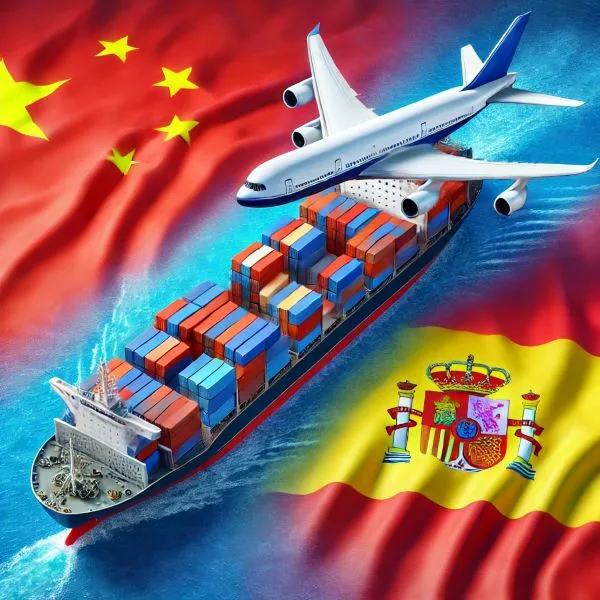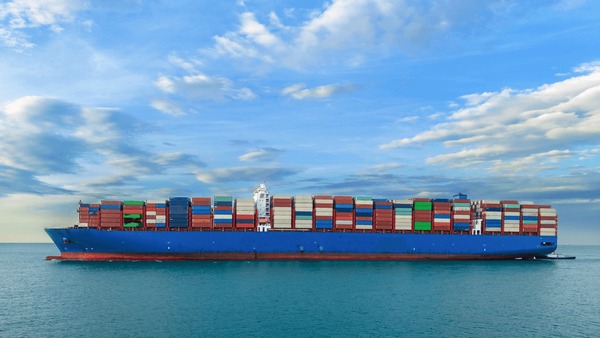- By TOP CHINA FREIGHT
- October 10, 2025
- Shipping
Table of Contents
Efficient logistics service China to Spain is essential for businesses managing international trade between the two countries. With increasing e-commerce demand and industrial cooperation, reliable logistics ensure smooth supply chain operations, cost control, and timely delivery. However, importers often face challenges such as customs clearance, shipment delays, and freight cost fluctuations. This guide explains everything you need to know — from shipping methods and costs to customs documentation and delivery strategies — to optimize your logistics process.

What Are the Main Logistics Options from China to Spain?




There are multiple logistics options when shipping from China to Spain. The choice depends on your cargo size, budget, and delivery urgency.
| Shipping Method | Transit Time | Best For | Approximate Cost | Advantages | Limitations |
|---|---|---|---|---|---|
| Air Freight | 3–7 days | Urgent, high-value goods | $$$ | Fastest option | Expensive for bulky cargo |
| Sea Freight (FCL/LCL) | 25–40 days | Large shipments | $$ | Cost-effective | Slow transit |
| Rail Freight | 18–25 days | Mid-sized cargo | $$$ | Reliable and eco-friendly | Limited routes |
| Express Courier | 3–5 days | Small parcels | $$$$ | Door-to-door service | High cost |
For most commercial shipments, sea freight remains the most cost-effective choice, while air freight is best for high-value or urgent cargo.
How Long Does Shipping Take from China to Spain?
Transit time varies based on the chosen shipping method and port locations.
| Route | Transport Type | Estimated Transit Time |
|---|---|---|
| Shanghai to Valencia | Sea (FCL) | 30–35 days |
| Shenzhen to Barcelona | Sea (LCL) | 35–40 days |
| Chengdu to Madrid | Rail | 18–22 days |
| Beijing to Madrid | Air | 5–7 days |
| Guangzhou to Madrid | Express | 3–5 days |
Logistics service China to Spain typically takes between 20–40 days for sea freight and less than a week for air freight. Planning schedules in advance helps avoid delays during peak seasons.
What Documents Are Required for Customs Clearance in Spain?

Customs documentation is a critical part of international logistics. Missing or incorrect paperwork can lead to shipment delays or penalties.
| Document | Purpose |
|---|---|
| Commercial Invoice | Details product value and transaction |
| Packing List | Describes quantity and packaging |
| Bill of Lading (B/L) or Airway Bill (AWB) | Proof of shipment |
| Certificate of Origin | Verifies product origin |
| Import License (if applicable) | Required for restricted goods |
| Customs Declaration | Submitted electronically for clearance |
To ensure smooth processing, always verify that your logistics service provider double-checks all documents before shipment.
How Much Does It Cost to Ship from China to Spain?

Shipping costs depend on weight, volume, mode of transport, and incoterms.
| Shipping Type | Average Cost per CBM / KG | Transit Time | Notes |
|---|---|---|---|
| FCL (20ft container) | $1,200 – $2,000 | 30–35 days | Ideal for large shipments |
| LCL | $60 – $120 per CBM | 35–40 days | For small loads |
| Air Freight | $5 – $10 per kg | 3–7 days | For urgent delivery |
| Express (DHL, UPS, FedEx) | $8 – $15 per kg | 3–5 days | Small parcels only |
Tip:
Consolidating goods and booking shipments early can help reduce logistics costs significantly.
What Are the Advantages of Working with a China Freight Forwarder?
A professional China freight forwarder simplifies the entire process. They manage carrier selection, documentation, customs clearance, and final delivery.
Key benefits include:
1.End-to-end coordination:
From supplier pickup to Spanish warehouse delivery.
2.Cost optimization:
Better freight rates through consolidated shipments.
3.Expert customs handling:
Minimized risk of delays.
4.Real-time tracking:
Enhanced visibility of goods throughout the supply chain.
Partnering with a reliable logistics service China to Spain ensures predictable transit times and cost control.
How to Choose the Best Logistics Partner for China to Spain Shipping?
Choose a company with established partnerships in both China and Spain.
Ensure full quotation breakdowns to avoid hidden charges.
Providers should offer air, sea, rail, and express solutions.
24/7 communication channels are vital.
In-depth knowledge of EU import regulations.
What Are the Main Ports and Hubs Between China and Spain?
China’s export network connects efficiently with Spain’s major ports.
| Country | Main Port / Hub | Description |
|---|---|---|
| China | Shanghai, Ningbo, Shenzhen, Qingdao | Key global export hubs |
| Spain | Valencia, Barcelona, Bilbao | Major entry ports for Chinese imports |
For air freight, Madrid Barajas Airport and Barcelona El Prat Airport handle most Chinese cargo flights. For rail, the Yiwu–Madrid line remains a leading Belt and Road route.
What Are Common Challenges in China–Spain Logistics?
Even with careful planning, importers may face:
- Customs delays due to documentation issues.
- Port congestion during peak export seasons.
- Freight rate fluctuations driven by global demand.
- Currency changes impacting total costs.
- Supply chain disruptions caused by geopolitical factors.
Pro Tip:
Mitigate risks by diversifying routes and maintaining strong supplier communication.
Case Study: Electronics Shipment from Shenzhen to Madrid

A Spanish electronics retailer needed to transport 8 tons of smart devices from Shenzhen to Madrid. Using a combined rail + truck logistics service, the cargo reached Spain in 21 days at 35% lower cost than air freight. Customs clearance was pre-arranged electronically, minimizing storage time at the terminal.
This example shows how hybrid logistics models can balance speed and affordability effectively.
Should You Use DDP or FOB Terms for Spain Imports?
FOB (Free on Board):
You handle freight and customs after departure. Best if you have experience managing international logistics.
DDP (Delivered Duty Paid):
The supplier or forwarder handles everything — from shipping to Spanish delivery, including customs and duties. Ideal for first-time importers.
For beginners, DDP logistics service China to Spain provides convenience and transparency, while experienced importers may prefer FOB for cost control.
Conclusion
In conclusion, choosing the right logistics service China to Spain ensures smooth transportation, efficient customs clearance, and predictable delivery schedules. Whether using air, sea, or rail freight, partnering with a professional forwarder can save time and money while maintaining supply chain reliability. By comparing options, preparing documents accurately, and planning ahead, you can achieve a seamless logistics experience for all China–Spain shipments.
Need a Shipping Quote?
Click below to get a free, no-obligation quote from Top China Freight.
We’ll respond within 24 hours with the best shipping options for your cargo.

FAQ
Q1: How much does it cost to ship a 20ft container from China to Spain?
On average, shipping a 20ft container costs between $1,200 and $2,000, depending on route and season.
Q2: Can I ship small parcels directly from China to Spain?
Yes, express couriers like DHL, UPS, and FedEx handle door-to-door small parcel deliveries from China to Spain.
Q3: What incoterm is best for importing from China to Spain?
For new importers, DDP is easiest since duties and customs are handled by the seller or forwarder. Experienced importers often choose FOB for more control.
Q4: Do I need an import license in Spain?
Not always. Most general goods only require standard customs documents, but restricted items need special permits.
Q5: How can I track my shipment from China to Spain?
Your freight forwarder will provide a tracking number or platform for real-time shipment updates.
